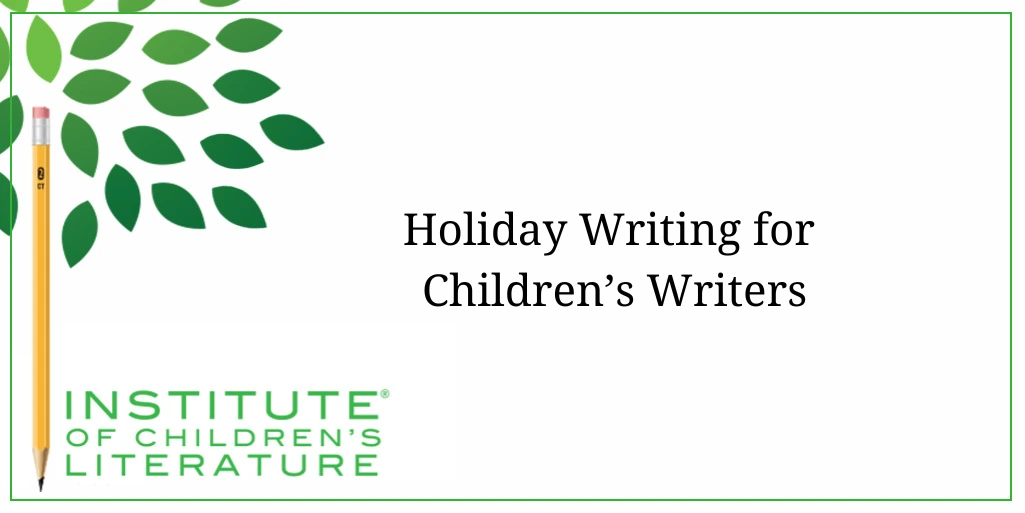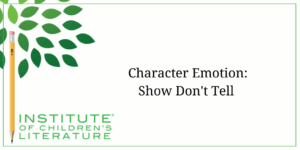
- Date: December 5, 2024
- Author: Jan Fields
- Category: Writing for Children Blog
- Tags: Craft, Holiday, magazines, Nonfiction, Picture Book, Picture Books, Short Stories, Short Story, YA
We teach our students how to write and get published!
View our Course Catalog >
Happy Holiday Writing for Children’s Writers
Holiday time is officially here and with it holiday writing. In fact, we've already been through a few big holidays with Thanksgiving and Halloween. During fall and winter, the holidays come fast and varied. And no matter what holidays you celebrate, stories lurk in the celebrations. Stories of family. Stories of friends. Stories of traditions.
This is a great time to watch for those stories popping up. Or to remember those stories from the past. Write those holiday stories down while they’re fresh, and the details are bright in your mind.
 While it isn't the best time to sell those stories, it is the perfect time to write them. Write them. Polish them. Then store them for later in the year when the markets that publish holiday writing put out their calls for submissions.
While it isn't the best time to sell those stories, it is the perfect time to write them. Write them. Polish them. Then store them for later in the year when the markets that publish holiday writing put out their calls for submissions.
Let's look at the two sides of holiday stories: writing and selling. They work hand in hand with any holiday writing you decide to undertake.
A Holiday Nonfiction Story Needs to Lingers
Holiday stories can be fiction or nonfiction. For the most part, short nonfiction stories from personal experience during the holidays will sell to markets like Chicken Soup for the Soul. This publisher produces an anthology every year that accepts holiday stories that are touching or funny, but that must be absolutely true. For these anthologies, the holiday is at the center of the story, but they're also looking for something that amusing or emotional. The story can be startlingly unique or comfortingly universal. But it must be well written. And it needs a kind of story arc. That means you'll write the event in a way that builds toward the ending. And you'll need both an engaging opening and a satisfying ending.
This kind of nostalgic remembrance of a holiday event needs to reveal something larger than itself.
For example, you might tell a touching story of the time your child worked all year, picking up odd jobs. And you assumed he was saving to buy himself a bike or other big-ticket treat. But he was very quiet about it. Then, on Christmas day, you're shocked when the child reveals a gift for a sibling, or perhaps one or both of the parents. Something he knew would be special and could never be bought without all his work. And that moment would show us things about family and love and generosity.
That's how holiday writing can be bigger than the story itself. It’s a story that reveals. A story that lingers. When telling true holiday stories, you want a story that resonates and stays with the reader.
Holiday Articles Can Reveal, Inform, or Inspire Readers to Create
Not all holiday writing is a nostalgic retelling of a real-life event. Some holiday nonfiction is simply an article. Many of us don't think about articles when we think of holiday writing, but this time of year is much bigger than we might think.
 The winter holidays, for example, have years of history and tradition behind them. Traditions change a great deal over time as do the foods we eat and the things we celebrate. So holiday nonfiction that reveals something we might not know about past celebrations, or the origins of common things today, is interesting.
The winter holidays, for example, have years of history and tradition behind them. Traditions change a great deal over time as do the foods we eat and the things we celebrate. So holiday nonfiction that reveals something we might not know about past celebrations, or the origins of common things today, is interesting.
For example, an article about the tradition of dressing up in creepy costumes and going house to house to scare and get treats has some surprising connections to traditions in the UK that happened deeper into winter. You might write a story about mummers. Mummers dressed up in disguises and visited homes. In some places, the mummers were expected to sing a song or do a dance. Thus, the tradition of mumming might have roots in both trick or treat, and carolers. Nonfiction holiday writing about traditions, change, and history can appeal to both magazines and book publishers.
Nonfiction during holiday time isn't just about telling family stories or looking at culture and history. How-to nonfiction is also popular. So are puzzles and jokes. Among how-to nonfiction, you might create a kid-friendly version of a traditional holiday food. Or you might offer a fun take on a holiday snack. You might create a craft that can work as a holiday gift, or perhaps a holiday decoration. All of these are common holiday nonfiction, and they are pieces that are needed every year around this time.
Crafts and recipes may need to be tailored to the place you intend to sell. Some markets like crafts and recipes where kids and adults work together. Some are looking for things kids can do on their own. So keep that in mind when you pick where you intend to send your seasonal material.
Holiday Fiction Picture Books and Board Books
Holiday fiction can be a tough sell. Every year, bookstores put out selections of special books for holidays. You may see holiday concept books. Perhaps you'll spot a concept book where a character is looking for presents under, around, in, on, and outside the home. Or maybe you'll see a book about the colors of the holiday. Or a board book that counts the spooky costumes.
 When you see specialized displays like this, you might think this means holiday stories are easier to sell since they have their own display and limited competition. These things are true, but only to a point, but there is more at play.
When you see specialized displays like this, you might think this means holiday stories are easier to sell since they have their own display and limited competition. These things are true, but only to a point, but there is more at play.
Holiday books are actually a tough sell. For one, they are only available for a short time, so all sales must be quick sales. They can last for years, being offered again and again, but in that case, the publisher has to believe the book will be timeless. They want something readers won't tire of. They want something that works for repeat reads. They want something they don't already have.
As a result, the best way to decide what to write about for a holiday picture book would be to read dozens of them. Read all the ones you possibly can. Spend this holiday season visiting the bookshops over and over and reading all the spooky books, all the Thanksgiving books, and all the winter holiday books. Take notes on what is available and ask yourself what about this book is different? Why did a publisher acquire it? What is the biggest draw the book offers to readers?
Sometimes a holiday story can be highly popular, for a time. Olive the Other Reindeer by J Vivian Walsh can still be purchased, but it doesn't have nearly the popularity it once held. It was wildly popular for a while. It even inspired a holiday cartoon. But it isn't the hit today that it once was. The book was clever and inventive and the art by J. Otto Seibold was bright and stylized. But the wild popularity of something like Olive the Other Reindeer or Polar Express by Chris Van Allsburg is rare. Most holiday books don't sell or linger nearly so well.
Publishers tend to reissue many of the holiday books that performed well (or decently well) the year before. That means they need fewer new holiday books. Thus, they buy few new holiday books. If you're writing a holiday picture book, the competition is going to be fierce. That doesn't mean you shouldn't do it. But it does mean you need to know the market, know what's already out there, and know that you're offering something new and engaging.
Holiday Fiction for Kids Who Read
Most of the time, holiday fiction for older kids—chapter books, middle grade novels, or YA novels—have to be about a lot more than the holiday. The holiday can feature. It can even inspire. But you need a book that can sell outside the holiday time. So it needs to be more than a holiday story.
 A YA book that is set during a holiday driving trip to visit family is a holiday story. But if the family car breaks down in a wilderness, and the family has to learn to work together to survive the weather and the situation, you have a book that is both a holiday story and a tense adventure story that could sell all year
A YA book that is set during a holiday driving trip to visit family is a holiday story. But if the family car breaks down in a wilderness, and the family has to learn to work together to survive the weather and the situation, you have a book that is both a holiday story and a tense adventure story that could sell all year
This is usually the case with holiday books for older readers (including adults). Often they are stories that are about something much bigger than the holiday. A story about how friends can be like family when family is too dysfunctional, can be set in a holiday time. But it's about something much bigger.
All of this is because publishers know parents may pick up holiday picture books on a whim if the covers are engaging, but that reading-aged kids are often looking for a good story. And that's what the buying adult will gravitate toward. So, holiday stories for older kids are less cutesy, unique versions of classic ideas, and more unusual handling of contemporary stories (or genres) that happen to be set in holiday time.
When you're submitting stories like this, focus on the story. Pitch it as a great story. The setting can be important, but it's not the primary feature. The primary feature is the story.
Fiction Isn't Nostalgia
A problem many newer writers run into when writing holiday stories is that they are trying to write a mildly fictionalized version of their own childhoods. As a result, the story often lacks a strong plot and little that resonates with readers. It feels like it resonates with the author because the experience that inspired it has lingered in the author's mind. So it must be important, right? Right. It's important to that writer. But it may only be important to that writer.
 You must be able to get some distance from the piece you've written in order to tell if it's working as a story. And that can be tough when you've written a memory of your own childhood or a memory of a time with your children. Those memories are precious. And they might make a good story. But they also might not. So I would recommend using them only if you have a good critique group or critique partner who doesn't mind telling you the truth when a memory-based story isn't working.
You must be able to get some distance from the piece you've written in order to tell if it's working as a story. And that can be tough when you've written a memory of your own childhood or a memory of a time with your children. Those memories are precious. And they might make a good story. But they also might not. So I would recommend using them only if you have a good critique group or critique partner who doesn't mind telling you the truth when a memory-based story isn't working.
Write Now, Sell Later
Whatever holiday material you're writing, you need to know that it might take a while before you can interest a publisher. Some publishers only accept holiday writing at certain times of the year. Some never publish holiday stories at all. Some have rules about what sorts of holiday content they publish. They may accept Christmas but not Santa. They may like spooky stories but not scary ones.
Because of this, it's especially important to study what the publisher has run in the past. If you're considering a book publisher but there are no holiday books in their line at all, then sending them your holiday story is certain to be a waste of your time and theirs. You can use Amazon and the book publisher's website to get a pretty good idea of what they've published.
Is Holiday Writing Worth the Risk?
Holiday writing can be fun. They take more work than other types of stories, but don't let that dissuade you. If you're willing to research the publishers, if you're willing to read lots and lots of holiday books, and if you believe in the story you want to tell, then go for it. Holiday stories can be wildly successful. They can become family favorites. But it's a bigger gamble than you may think. It's good to go in with both eyes open. And a jingle in your step.
Happy Holiday writing!
Related Articles
With over 100 books in publication, Jan Fields writes both chapter books for children and mystery novels for adults. She’s also known for a variety of experiences teaching writing, from one session SCBWI events to lengthier Highlights Foundation workshops to these blog posts for the Institute of Children’s Literature. As a former ICL instructor, Jan enjoys equipping writers for success in whatever way she can.




